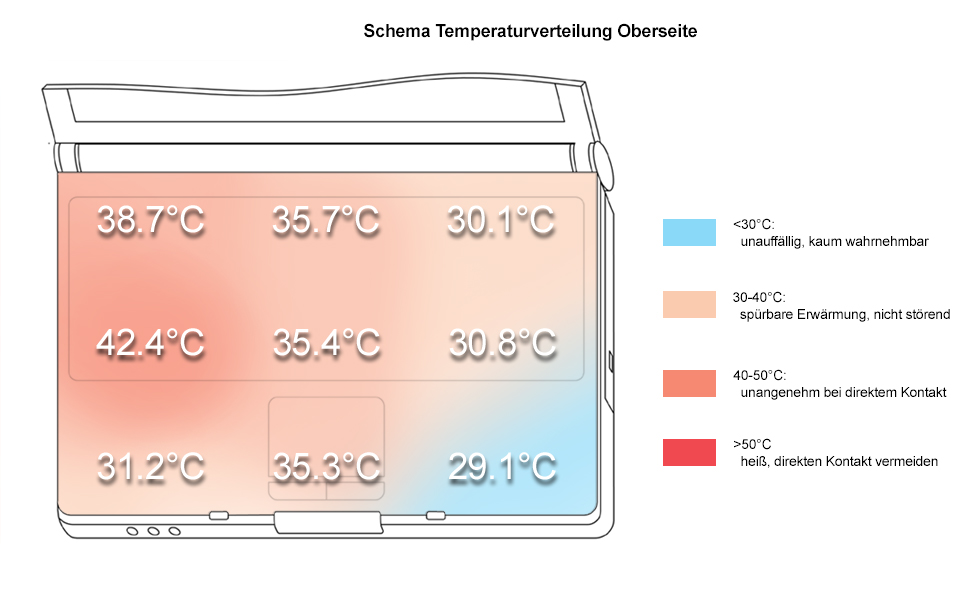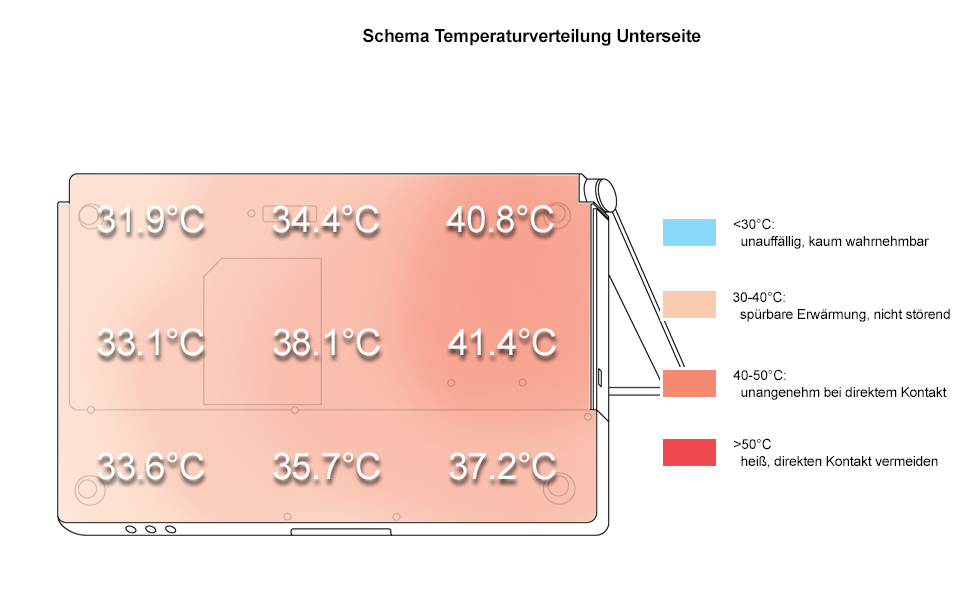Review Samsung X60 Pro Notebook
Case
The X60 Pro (also called X60plus) is in a manner of speaking a remake of the Samsung X60 with Core Duo CPU. In order to be up to the present mark, it is equipped with a powerful Core 2 Duo CPU and also a new video card produced by ATI - the Mobility Radeon X1700.
The X60 Pro wants to attract by an angular and geometric design. The very slim design impresses.
The case out of magnesium alloy, which on the one hand has very good haptics and at the same time allows astonishing stiffness at very small dimensions, convinces. The low weight of only 2.5 kg is another pro of the X60.
Even at a closer look one can hardly detect any weaknesses regarding workmanship. The surfaces are very pressure resistant and we could hardly observe any creaking noises plying the notebook. The only weakness we detected is the battery which wobbles a little bit, but this gets obvious only during mobile use.
Next to the battery there is a LED which displays the state of charge. It can be activated by slightly pressing it and displays the remaining capacity in 20% steps without the need of turning the notebook on.
Both of the long hinges allow to position the display without any see-saw. The force which one needs to apply for it is comfortable. The display comes with a ramshorn hook, but despite it a slight wobbling is possible, if the display is closed. The bolt which allows unlocking the display is comfortable in use.
The placement of the interfaces is alright. Ports which are likely to be used permanently at a desk, e.g., VGA out, LAN and two USB ports are either at the backside or at the left back corner. The audio ports (S/PDIF) are at the left side in the center and near the front. Furthermore, the notebook has a docking port at its bottom side.
The overall layout of the keyboard as well as those of singular keys is angular and fits well to the X60's total experience. Despite of this design the keys feel very good and are comfortable in use.
Typing strengthens this positive appearance. It can be characterized by a clear point of pressure, an average travel and a soft stop. They keys are all together of comfortable size and even the layout seems to be proper. The typing noises are rather decent.
Furthermore, we could observe that the keyboard is not completely firmly attached at some parts of its edges. Therefore, it's typing noise can be a little louder in this regions.
The Samsung X60's touch pad has a slightly coarse surface with good sliding properties even if the fingers aren't completely dry. Additionally, its form is nice and it has been placed nearly at the same level than the case.
In general it reacts well and allows to control the mouse pointer precisely, however, sometimes the mouse pointer still reacted unlike expected. Both buttons can be used at there complete extent without any problems without the need of applying too much force. There clicking noise, especially those of the right button might be a little too loud.
At the right side besides the keyboard there are some additional keys, which allow to control the AVStation software and the volume of the speakers.
Display
The Samsung X60plus is equipped with a non-reflection (NonGlare) 15.4 inch wide screen display with a maximum resolution of up to 1680x1050. The fineness is therefore 128.6 dpi. Because of this, there is much space at the display which helps gaining overview, on the other hand the fonts are already rather small.
The maximum brightness was only 116.3 cd/m². Against our expectations these value was not measured in the center of the display, but in the left bottom corner. The illumination of 61.9% is also poor and this can be recognized even with the naked eye.
In general the measurement diagram does not discover any anomalies, only the usual slight deviation of the blue color curve, which leads to warmer colors.
| |||||||||||||||||||||||||
Brightness Distribution: 62 %
Contrast: 521:1 (Black: 0.2 cd/m²)
Because the minimum brightness (black value) is only 0.2 cd/m², the calculated maximum contrast of the display is very good 581:1.
Grade 6 in the Pixperan test of legibility is an average result regarding the display's speed of reaction.
On the record the X60 is equipped with a NonGlare display, i.e. it has a non-reflecting surface. However, among the non-reflecting displays, I would count it among somewhat more reflecting displays. Especially, if the vantage point deviates a lot from the optimal vertical vantage point, slight reflections can still be observed despite of it.
Outdoors the display's surface has a positive impact on possible reflections. However, it gets obvious that the display's illumination is a little too weak, because in bright environments the displayed content appears rather dark.
The stability to the vantage point is in general relatively good. Vertically as well as horizontally the area of operation is wide. Especially at acute angles the contrast diminishes.
Performance
In the Samsung X60 Pro either a T7200 or a T7400 CPU provides service. Therefore, the notebook has sufficient reserve capacity even for future demands. The reviewed notebook was equipped with 2048MB PC5300 main memory too, which had a positive impact on the performance. A maximum of 3GB main memory is possible, but this clearly increases the costs, because 2GB Ram modules are still rather expensive.
Regarding the video card, a ATI Mobility Radeon X1700 video card with 256MB video ram is installed. By means of it, this notebook becomes a multimedia notebook, which is besides video and graphical applications capable of handling even current games without any problems. Regarding performance the X1700 clearly exceeds the ATI’s X1600, which is its predecessor, and also its competitors of NVidia (Geforce 7600) - at least regarding the 3DMark05 benchmark comparison. In the 3DMark 06 comparison it was marginally worse than the Geforce 7600.
NVidias direct reply to the X1700, the Geforce Go 7700 should still be clearly better than the X1700.
The especially big hard disk with a capacity of 160GB and 5400 revs, has comparably good transfer rates and access times, which are nearly as good as those of some 7200 revs models.
Further information about the video card can be found here or in our comparison of mobile video cards. Detailed information about the Core 2 Duo CPU can be found here.
Please also look at our benchmark list of mobile processors or at our benchmark list of mobile video cards, in order to compare this notebook to other configurations.
| 3DMark 2001SE Standard | 20821 points | |
| 3DMark 03 Standard | 7054 points | |
| 3DMark 05 Standard | 4193 points | |
| 3DMark 06 Score Unknown Setting | 1829 points | |
Help | ||
| PCMark 04 Standard | 7376 points | |
| PCMark 05 Standard | 4859 points | |
Help | ||
Further reviewed:
Cinebench 2003
Rendering (Single) : 373 CB
Rendering (Multiple): 675 CB
Shading (CINEMA 4D): 412 CB-GFX
Shading (OpenGL Software Lighting): 1668 CB-GFX
Shading (OpenGL Hardware Lighting): 4140 CB-GFX
Call of Duty II
800x600, AA off: 35-50 fps
1024x786, AA off: 30-45 fps
1024x786, 2xAA: 20-35 fps
1024x786, 4xAA: 20-25 fps
Emissions
Loudness
During idle mode or nearly no load, e.g., during surfing or text processing, the fan stays deactivated most of the time and the notebook is pleasingly quiet. Sometimes the fan is turned on and causes a noise level of about 36.8 dB, but because of it swishing noise one can still live quiet well with it .
Under load the maximum a maximum loudness of 44.3 dB is reached, which can be heard clearly, but, because of its low frequency, it is hardly disturbing.
Noise level
| Idle |
| 33.1 / 40.7 / 36.8 dB(A) |
| HDD |
| 37.1 dB(A) |
| DVD |
| 36.8 / dB(A) |
| Load |
| 0 / 44.3 dB(A) |
 | ||
30 dB silent 40 dB(A) audible 50 dB(A) loud |
||
min: | ||
Temperature
The magnesium alloy of the X60's case does not only ensure a good flexural rigidity, is also ensures that the temperature emissions are distributed more or less evenly over the whole surface. Interestingly enough the maximum temperature of the X60 could not - as usual - be measured at its bottom side, but at the top side at the left edge of the keyboard marginally above the fan. 42.4°C maximum temperature are yet alright and do not disturb using the notebook, because of its locations at the notebook's outer edge.
Upper side
palmwrist: 31.2°C max: 42.4°C avg: 34.3°C
Bottom side
max: 41.4°C avg: 36.2°C


Speakers
The speakers are left and right above the keyboard behind a rather fine perforated metal cover. Their sound is satisfying, even at maximum volume the sound was clear. Basses are missing, which is rather usual for notebooks without separate sub-woofer.
Battery Runtime
The measured battery runtime is, considering it is a multimedia notebook, average and partly below-average. Under load it is possible to use the X60 Pro with 5200 mAh battery for only nearly an hour. Under load with maximum energy savings settings and with minimum display brightness the runtime is slightly above 3 hours.
WLan and DVD playback should be possible for about 2 hours.
| Off / Standby | |
| Idle | |
| Load |
|
Key:
min: | |
Verdict
The Samsung X60 is not really cheap, however, the quality of the used materials and the workmanship are alright. The magnesium case convinces through its robustness and flexural rigidity and at the same time the low weight and the small dimensions.
Additionally the notebook's design appears to be elegant and of high-quality.
The input devices too, especially the keyboard, left a good impression. It is clearly structured, has big keys and also good and desired typing comfort.
The display is not as good as the other rather good properties of this notebook. Especially relatively the low brightness and the illumination should be improved. On the contrary, the stability to the vantage point, the contrast and the non-reflecting surface were well able to convince.
The performance of the Samsung X60 Pro is excellent. The Core 2 Duo processor and the ATI Mobility Radeon X1700 provide very good performance in the fields of applications and 3D. The 160GB hard disk too could reach good ratings in our benchmarks.
The noise emissions could convince especially during idle mode. Even if the fan is on, it does not really disturb, because of its low frequency noise.
The battery runtime is not so good, and limits the time for unplugged work in practice to about two hours.
Many thanks to the company Notebook-Shop.de, which provided us with the notebook for this review. You can configure and buy the notebook here.























































